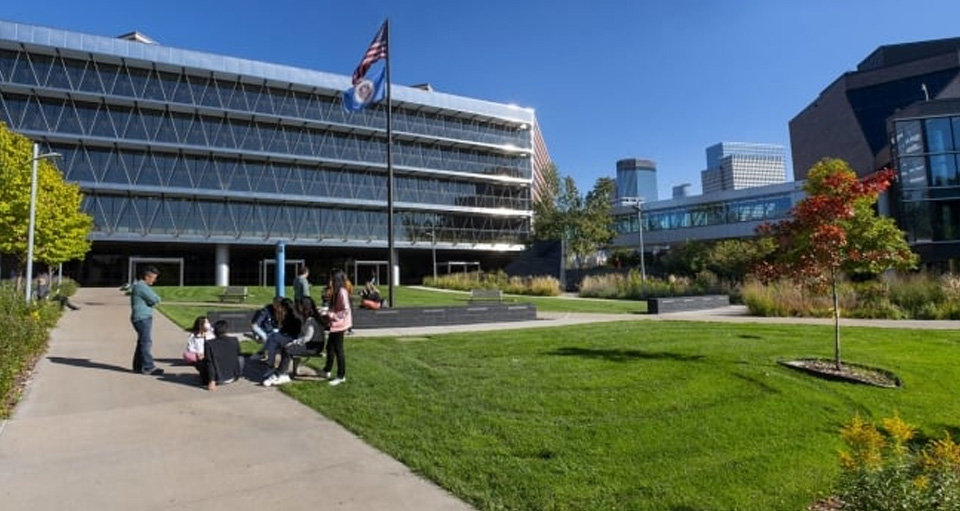State Support Turns Minnesota’s Enrollment Tide

Enrollment at public colleges rose for the first time in a decade. Higher ed leaders credit historic state funding and innovative college access initiatives.
For the first time in over a decade, enrollment is up at Minnesota’s public colleges
and universities, thanks to a record year of state funding and investment in a slew
of new college-access initiatives.
The surge was most evident at the Minnesota State Colleges and Universities System,
which includes 26 community and technical colleges in addition to seven four-year
institutions. Enrollment rose 2 percent system-wide and 3.7 percent at two-year institutions,
while numbers remained relatively stable at the four-year colleges, according to system
officials.
“We haven’t seen numbers like this in a decade or more,” said system chancellor Scott
Olson. “It’s a good moment for Minnesota.”
The bump is especially impressive considering the precipitous declines that nearly
all system campuses underwent over the last few years. Between 2018 and 2022, undergraduate
enrollment at the system’s four-year institutions fell by nearly 10,000, a decline
of about 25 percent, according to data from the Minnesota Office of Higher Education;
enrollment at two-year colleges fell by over 20,000 students in the same period.
The boost, Olson said, is directly tied to a marked increase in state support for
higher ed. After years of level funding, the legislature approved what he called a
“historic” increase of nearly $650 million, bringing the total higher ed investment
to around $4 billion.
The largest and most impactful focus of that expenditure is a new financial aid initiative,
North Star Promise, under which students from families making less than $80,000 a
year will receive free tuition to any public college in the state they’re admitted
to. The program takes effect in the fall, but students will begin receiving financial
aid offers reflecting the waiver over the next few months. About 15,000 students are
likely to qualify, according to estimates from the Minnesota Office of Higher Education.
“We hit an enrollment peak 10 or 12 years ago, and since then had year-on-year declines
that were exacerbated by the pandemic,” Olson said. “But the partnership we have now
with the legislature, with the governor … it has really reversed that trend.”
The effects may keep compounding. Olson said applications to system campuses are up
19 percent over last year, a surge he attributes to the array of innovative new college-access
and recruitment initiatives. In addition to the North Star Promise, tuition was frozen
this year, and the state’s Direct Admission program—in which participating colleges
automatically accept students who meet academic eligibility requirements—is now in
its second year.
Caitlyn Cole, director of career and college readiness at Achieve Twin Cities, a nonprofit
that helps high schools in Minneapolis and St. Paul prepare students for postsecondary
education, said this is the most optimistic she’s been about higher ed in Minnesota
in her ten-plus years in the field. She primarily works with low-income, first-generation
students, and she said demand for her organization’s services is at an all-time high.
“We’ve seen the highest engagement with our programming that we’ve ever had,” she
said. “I’ve never seen things shift so quickly.”
Following the North Star
Olson said one of the biggest factors in pushing such initiatives over the finish
line was the massive $3.7 billion budget surplus Minnesota had this fiscal year. While
many states entered FY2023 with overflowing coffers, few invested that surplus back
into higher education (though FY2024 saw an overall rise in state higher ed funding).
Numerous studies have linked the general decline in state investment since the early
2010s with a corresponding affordability crisis and decline in college-going, especially
at poorly resourced regional public colleges. Meanwhile, lawmakers in states like
Pennsylvania—where colleges are facing some of the most dire enrollment challenges
in the country—are unwilling to increase or even maintain funding for higher education.
So why aren’t more states following Minnesota’s lead?
Olson said part of the issue comes down to values. The free tuition program’s name,
North Star, is a symbol of Minnesota’s “unwavering commitment to the core value of
education,” Olson said, which he’s associated with his home state since childhood.
But funding alone isn’t enough; the enrollment surge is also a result of the way Minnesota
invested, which Olson described as a “partnership” between lawmakers and institutions.
Tuition freezes have become much more common in recent years, according to a 2023
study from the State Higher Education Executive Officers Association. But Minnesota’s
tuition freeze was not an unfunded mandate, like the recent freeze Pennsylvania lawmakers
ordered. Instead, it was accompanied by funding to ensure public institutions could
weather the lack of a tuition increase.
“We froze [tuition] for two years and we paid for it—that’s a critical component,
that we paid for it, so there wouldn’t have to be cuts,” said State Representative
Gene Pelowski, a Democrat who championed the tuition freeze and helped push through
record higher ed spending.
Robert Kelchen, head of the University of Tennessee Knoxville’s department of educational
leadership and policy studies, said that kind of investment is rare but crucial for
addressing enrollment declines. The sheer marketing impact of the words “free tuition,”
he said, should not be underestimated.
“It’s different than even meeting the standard appropriations needs of institutions,”
he said. “Students can see and feel the benefits of this spending. That makes a real
difference.”
The funding boost wasn’t motivated entirely by a pure love of education, though; Minnesota,
like many states, faces a serious workforce shortage in fields such as social work,
healthcare, teaching and vocational trades. Pelowski said the state’s investment should
see a return in the next several years in the form of more skilled workers training,
and staying, in Minnesota.
“It’s addressing a crying need,” he said.
Two Birds, One Stone
Olson said his system’s enrollment has spiked more than the University of Minnesota
system—which is separate and operates the state flagship, UMN Twin Cities, along with
four regional campuses—because Minnesota State’s campuses, like most community colleges
and regional comprehensive universities, primarily serve lower-income state residents.
Higher education’s national enrollment crisis coincides with an affordability crisis
as well. Cole said that in Minnesota, the results show the two are intertwined, and
that public policy that addresses one will undoubtedly ease the other.
“When you tell students about these programs, when you say ‘Hey, you don’t have to
worry about this tuition bill, that’s not going to be a factor for you,’ it really
changes the calculus” on college-going, she said. “There’s that spark in their eyes
and suddenly they can stop worrying about affording college and start planning for
how to make the most of it.”
Other states are taking notice. North Dakota, which shares a border with Minnesota,
has been trying to formulate its own answer to the North Star Promise since last spring,
worried that students from Minnesota—who make up more than a quarter of the student
body at some North Dakota campuses—will remain in-state in the future. South Dakota,
taking a different tack, ended its tuition reciprocity agreement with Minnesota two
weeks ago.
Pelowski said he’s seen neighboring states and competing private institutions alike
scramble to formulate their own affordability promises in the wake of Minnesota’s
commitment. He hopes to see a continuation of this “ripple effect,” and says the ensuing
competition could drive costs down and college-going up across the demographically
challenged Midwest.
“This has had an impact on higher education that was long overdue,” he said. “For
too long, higher education has said ‘we’ll just raise tuition.’ Those days are over.”
